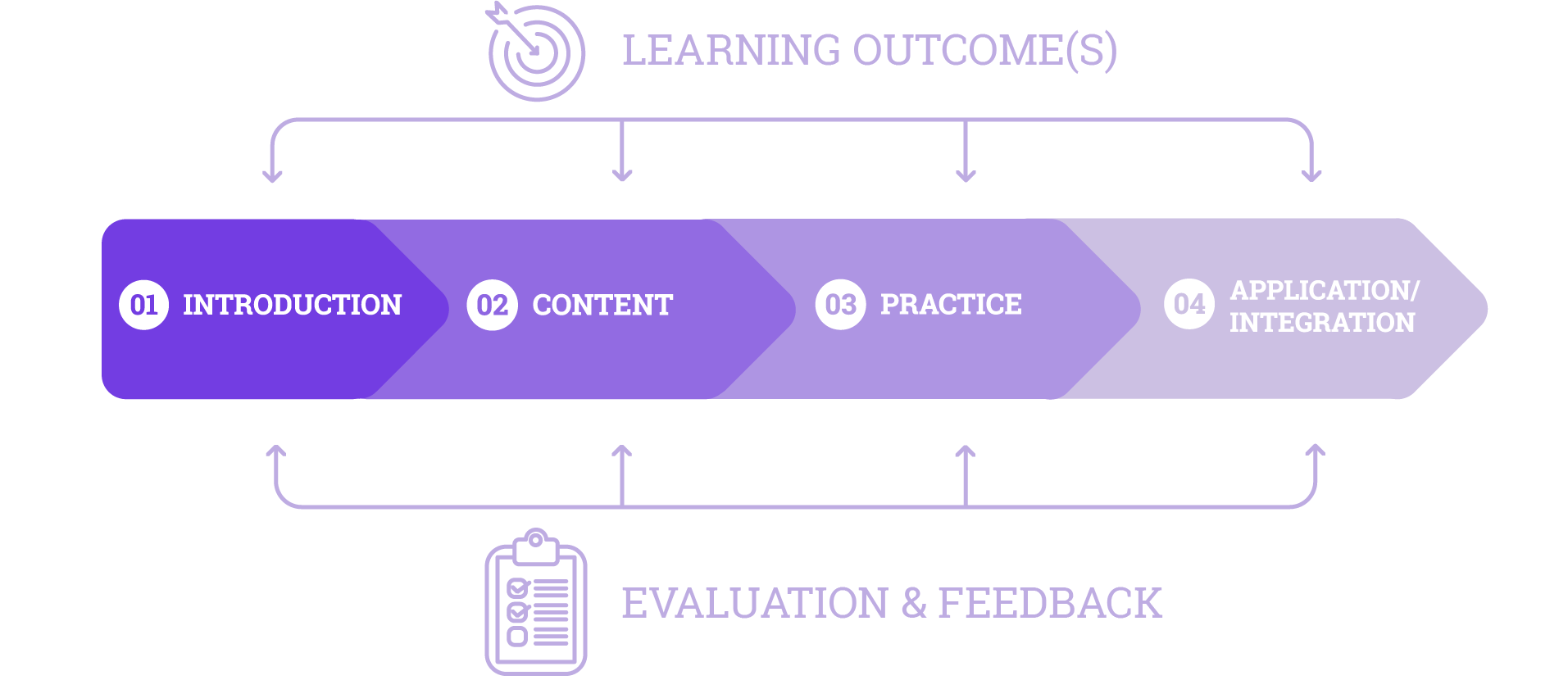This phase should be approximately 2-4 hours of work per week in a usual three credit, 13-week course.
After you have identified your course learning outcomes and determined how you will assess students, you can begin to start planning the learning activities that support students in achieving those learning outcomes.
The best way to approach the design of course online learning activities is from a module approach. Moodle is organized into "sections", which is where all the activities related to one topic are organized, and there is a clear separation from one section to the next. These sections are typically organized in a weekly format; however, without the confines of a usual academic week, instructors are free to organize these sections into modules that span as little or as much time as needed for the specific content.
For example, you may choose to have 6 modules over a thirteen week course, with one week at the end for review activities. In this case, you may only meet students synchronously once every two weeks, or you might decide to meet once briefly at the beginning to introduce the topic and follow up with some discussion or problem-solving activities the second week.
Create a Template for your Module
It is recommended to consider implementing pattern structure for your modules to help with consistency and set expectations for students. This will also make it easier to plan each week. For example, you might know that each module will look something like this*:
*This is an example only, and individual course templates will depend on target content and skills, learning outcomes, etc.
Preparing your online coure in advance
You do not need to have all modules of your course ready to go on Moodle before the first day of class. Many instructors develop their Moodle activities on a week-by-week basis, staying ahead of the class by a week or two. This is feasible if you already have plan for the modules.
The CTL recommends that you have a minimum of 2-3 weeks ready on Moodle by the first day of class. This will ensure that you have enough time to work on subsequent modules, but can make adjustments as needed for activities that are not working.
The most commonly used Instructional Design Frameworks include: Gagné’s Nine Events of Instruction, WIPPEA, Merril’s First Principles and the 5E Instructional Model outline the process for designing a learning experience – from analyzing the audience to implementing and revising instruction.
Although each of these frameworks is different, they all have three things in common:
These three components are essential in the design of instruction whether it be online or face-to-face.

The following guidelines are intended to assist faculty in applying the essential components for instructional design as they plan and organize their instructional activities for their course.
Some things to keep in mind as you start planning instruction:
Once you are ready, follow the steps below to plan your unit.
While your course learning outcomes are broad statements that cover the entire course curriculum, it is good practice to break those down into more discrete outcomes for each week/module when possible. This will help you target a subset of the knowledge, skills or values in your course-level learning outcomes that will build as the course progresses each week.
The main purpose of the Introduction is to:
All of the above activities will provide you with feedback as to where students are with the topic.
For more information on designing activities, refer to Desiging Online Activities.

This phase should be approximately 2-4 hours of work per week in a usual three credit, 13-week course.
In this phase of instruction, students will be engaging with the content. The typical ways students are introduced to new content is by: reading, watching a video (demonstration, simulation, worked problem, etc.), watching a video lecture, and participating in an experience.
Regardless of the instructional strategy you use to present your content, it should support the learning outcome and any extraneous or “nice-to-know” information should be kept to a minimum to help manage the cognitive load.
The best way to determine how students will engage with the new content is to pinpoint exactly what knowledge, skills and values students need in order to achieve the learning outcomes, and then start to find content that helps support those outcomes.
Tips for developing content activities
With your content selected, you can begin planning the learning activities.
The following activities are just some examples of how you can get students to engage in the course content.
For more information on designing activities, refer to Desiging Online Activities.

This phase should be approximately 3-4 hours of work per week in a usual three credit, 13-week course.
In university teaching, the presentation of content is commonly the focus of instruction. However, the Practice and Application phases of instruction are equally, if not more important, in the learning process because they target the students’ understanding of the specific content and performance skills.
When designing these activities, keep in mind that they will need to focus specifically on new knowledge and skills and should be relatively simple but sufficiently challenging. Remember - we are not assessing their knowledge here, we are helping students develop their knowledge and skills in this phase, so this is the ideal time for instructor support and feedback.
It is important that they have the opportunity to practice several times before consolidating it with other knowledge.
Tips for planning effective practice activities
Practice might include repetitive problem-solving activities and practice using equations. It might also include knowledge checks on specific terms, definitions, etc.Here are just some of the types of activities:
The practice phase also relates to “practicing” content, such as theories, concepts and ideas. In this case, students are engaging with content and negotiating meaning of the content through analysis and reasoning. The following are only some of the types of activities that can be used:
For more information on designing activities, refer to Desiging Online Activities.

This phase should be approximately 1-3 hours of work per week in a usual three credit, 13-week course.
In this phase of instruction, students apply new content and skills and integrate these with previous knowledge. The activities should provide opportunities for students to incorporate new and prior knowledge and apply it to new situations. The goal is for students to practice using the new knowledge and skills in tasks that mimic real-world applications.
Tips for planning effective application activities
It is possible that you will not have an application activity each week or in each module. You may design your application activities to help students integrate content and skills spanning over a series of weeks or modules.
Here are just a few examples of the kinds of activities to help students apply new knowledge and skills:
For more information on designing activities, refer to Desiging Online Activities.
If you are not sure how to adapt your course, please find a couple of sample module "templates" below to help you plan your own course.
If your typical face-to-face lecture time was structured as...
...your online course might look like this:
...your online course might look like this:
© Concordia University